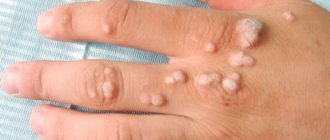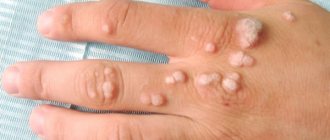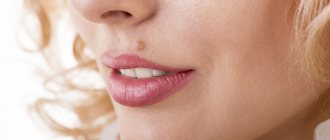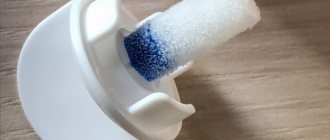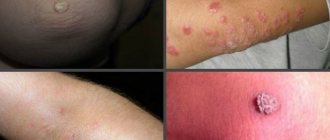04/26/2018 I was prompted to write this article by an overwhelming number of questions like: “Can I remove warts at home using various solutions?”
Today I will do a short review of wart removal products and together we will try to figure out how safe and effective such methods are. We will also look at what evidence of effectiveness there is for certain substances.
Flat wart on index finger
Plantar wart removal price
The cost of removing plantar warts in Moscow can vary and reach several thousand rubles.
Before removing the spine, you need to clarify the cost of the manipulation. Many clinics indicate a low cost in their price list. Most often, this means that the true price is veiled and at the appointment it turns out that you need to pay extra for anesthesia, bandaging, etc.
In our clinic, the price list indicates the full price of the intervention, i.e. no additional payments will be required.
Consultation with a doctor at the initial appointment - 1500 rubles
Removal of a plantar wart— RUB 1,500
What is Dimexide used for?
The drug is prescribed for problems with the functioning of the musculoskeletal system. In addition, in case of subcutaneous damage to soft tissues, Dimexide actively relieves the inflammatory process. The ability of the drug to enhance the effect of other drugs is often used by doctors in antibacterial therapy. Direct indications for prescribing Dimexide are:
- bursitis;
- arthrosis;
- arthritis;
- radiculitis;
- gout;
- osteochondrosis;
- pain syndrome due to intervertebral hernia;
- scleroderma;
- skin ulcers;
- swelling accompanied by pain;
- synovitis
In addition to the above problems, Dimexide is also used in other areas, including cosmetology.
Features, symptoms of plantar warts
The spine is a compaction on the plantar surface of the foot with a diameter of 2 to 10 mm (sometimes more). The formation resembles a small callus, which can be either flush with the skin or slightly raised above it. The presence of microscopic dark spots on the surface (thrombosed capillaries) is considered characteristic. Color – from white-yellow to brown. The wart is dense to the touch, pressing on it causes pain.
The spine differs from ordinary warts and papillomas in its higher density, as well as pain when pressed. This is due to the fact that, due to their location, they are always subject to pressure and stress, which causes them to become keratinized; in appearance they sometimes resemble small calluses. The same factor causes pain - when pressed, a dense wart presses on deeper tissues, causing pain (a comparison with a pebble in a shoe is appropriate here).
Removal of plantar warts should be carried out by a specialist. Attempts at self-removal, as well as treatment with folk remedies, are usually ineffective, because the spines are highly dense and have deep “roots.” Superficial removal (cutting with forceps after steaming, applying celandine, aloe, etc.) usually leads to relapse.
Indications for the drug Viferon®
Ointment
viral (including herpetic) lesions of the skin and mucous membranes of various localizations;
treatment of influenza and acute respiratory viral infections in children over 1 year of age.
Gel
in complex therapy of ARVI, incl. influenza, frequent and prolonged acute respiratory viral infections, incl. complicated by bacterial infection;
prevention of acute respiratory viral infections, including influenza;
in complex therapy of recurrent stenotic laryngotracheobronchitis;
prevention of recurrent stenosing laryngotracheobronchitis;
in complex therapy of acute and exacerbations of chronic recurrent herpetic infections of the skin and mucous membranes, incl. urogenital form of herpetic infection;
in complex therapy of herpetic cervicitis.
Suppositories
In complex therapy:
ARVI, including influenza, incl. complicated by bacterial infection, pneumonia (bacterial, viral, chlamydial) in children and adults;
infectious and inflammatory diseases of newborns, incl. premature babies: meningitis (bacterial, viral), sepsis, intrauterine infection (chlamydia, herpes, CMV infection, enterovirus infection, candidiasis, including visceral, mycoplasmosis);
chronic viral hepatitis B, C, D in children and adults, incl. in combination with the use of plasmapheresis and hemosorption for chronic viral hepatitis of pronounced activity, complicated by cirrhosis of the liver;
infectious and inflammatory diseases of the urogenital tract (chlamydia, CMV infection, ureaplasmosis, trichomoniasis, gardnerellosis, papillomavirus infection, bacterial vaginosis, recurrent vaginal candidiasis, mycoplasmosis) in adults;
primary or recurrent herpetic infection of the skin and mucous membranes, localized form, mild to moderate course, incl. urogenital form in adults.
Reasons for appearance
As mentioned above, the main cause of warts is the human papillomavirus (HPV). The presence of HPV in the body is quite common. But the mere fact of the presence of a virus does not necessarily mean the appearance of papillomas.
Predisposing factors are:
- Poor foot hygiene
- Sweaty feet
- Skin trauma - abrasions, microcracks
- High virus activity
- Certain types of virus
- Decreased antiviral immunity
- Some common diseases that reduce the trophism (nutrition) of the skin of the foot are diabetes mellitus, polyneuropathy, arterial atherosclerosis
There are many types of human papillomavirus. Some of its varieties can cause the development of malignant tumors. The virus that causes plantar warts is not one of them. Spines never become malignant, but can cause other inconveniences - pain, cosmetic defects.
Removal of plantar warts
Peculiarities
When removing spines, you need to consider the following features:
1. Location on the sole increases the wound healing time (due to constant mechanical impact, sweating, etc.).
2. They are always removed deeply, forming a “crater”. Superficial removal is fraught with the risk of leaving the “roots” of the wart and recurrence.
3. “Home treatment” with folk remedies is undesirable, because with it, it is not possible to achieve the optimal depth of exposure, or, on the contrary, extensive chemical burns occur with various substances used for these purposes.
Methods
There are several methods for removing spines. They all boil down to the destruction of the wart, but this is achieved through various methods of influence, which can be divided into three groups:
- Destruction (destruction using laser, radio waves, electrocoagulation)
- Chemical destruction using various substances (liquid nitrogen, salicylic acid, alkalis, etc.)
- Surgical excision
Let's take a closer look at these methods:
Destruction methods are the most effective, because they destroy the wart completely and with high precision. The radio wave method should be considered the most optimal. It involves the most gentle and at the same time deep removal of the spine. During laser removal, the depth of penetration may not be sufficient to destroy the “roots” of the wart, which can lead to recurrence. When removed with an electrocoagulator, excessive damage to surrounding tissue occurs, which leads to longer wound healing and the formation of a rougher scar.
Chemical destruction is not very effective in treating plantar warts, but is more suitable for removing small papillomas on other parts of the body (i.e. those small formations that rise above the surface of the skin). Plantar warts are located almost flush with the skin and spread quite deeply inward. Therefore, the effect of a chemical on them is either not enough to completely destroy the wart, or, on the contrary, it is too extensive and causes chemical burns of the surrounding tissues, sometimes with the formation of long-term non-healing ulcers.
Surgical excision is rarely used for two reasons: firstly, extensive excision involving healthy tissue is simply not necessary and unreasonably increases the volume and invasiveness of the intervention. Secondly, the plantar surface of the foot is subject to constant mechanical stress (plus sweat production, limited “ventilation” of the wound due to shoes). All this greatly increases the risk of suppuration under the sutures. Surgical removal is advisable in cases where the wart is suspicious of a malignant formation and a high-quality histological (under a microscope) examination of the removed material is required.
Reviews of Ichthyol ointment
Ichthyol ointment is a multifunctional product at a low cost, therefore, according to most consumers, it must be present in every home medicine cabinet.
The drug has found wide use for abscesses and eczema , it is used as a remedy for boils and acne, it is used to treat burnt skin and broken knees, and to treat thrush and hemorrhoids .
Many women claim that the drug is an indispensable tool for combating skin imperfections. The use of Ichthyol ointment for acne - reviews and photographs confirm this - allows you to relieve inflammation (regardless of its type), disinfect the affected area, reduce the size of acne, accelerate the release of the purulent contents of pustules and the resorption of subcutaneous pimples, as well as reduce their pain, narrow pores, remove peeling and soften the skin.
There are also many references on the Internet to the use of ichthyol for hemorrhoids . Reviews indicate that in cases where the disease is not too advanced, the drug will solve and effectively solve this delicate problem.
Almost everyone calls the only disadvantage of the product its unpleasant smell, but the mass of beneficial properties and the complex effect of the drug completely cover this disadvantage.
How does the removal itself take place?
At the appointment, the doctor clarifies complaints, the duration of the disease, conducts an examination, and clarifies the presence of concomitant diseases and allergies to medications.
If the diagnosis is confirmed and there are no contraindications, intervention is performed. After treating the skin with an antiseptic, local anesthesia is administered with a thin needle. This may cause some pain (like any injection), but then the removal itself is completely painless. After making sure that the anesthetic has worked, the doctor destroys the wart with a radio wave scalpel. After removal, the wound is treated with fucorcin and a bandage is applied. The entire intervention takes 2–3 minutes.
Side effects
Ointment: in most cases, VIFERON® is well tolerated. When applied to the nasal mucosa, side effects are weak and transient and disappear on their own after discontinuation of the drug.
Gel: in extremely rare cases, a local allergic reaction may occur in some highly sensitive individuals. In such cases, stop using the drug.
Suppositories: in rare cases - allergic reactions (skin rashes, itching). These phenomena are reversible and disappear 72 hours after stopping the drug.
Where can a plantar wart be removed in Moscow?
We can definitely say that spines need to be removed in a clinical setting; the intervention should be carried out by a qualified surgeon who has extensive experience in treating such pathology. In Moscow, this can be done by Dr. Igor Vitalievich Elshansky. He will remove the formation using the optimal radio wave method. The intervention is painless, performed under local anesthesia, and after the manipulation the patient can immediately go home. The clinic has all the conditions for qualified removal.
Don’t expect the wart to “go away” on its own, don’t try to remove it yourself, contact a professional!
Levomekol in the treatment of burns
For burns, Levomekol is needed to prevent infection of the wound surface with pathogenic infections, as well as to accelerate tissue healing. Levomekol also copes with inflammation, which can lead to suppuration of the wound. The ointment cleanses the affected area well from both purulent discharge and necrotic cells.
The treatment system for a small area burn of 1-2 degrees is as follows:
- before applying the ointment, the wound is washed under running water;
- the ointment is applied to a sterile gauze pad, which is applied to the wound surface;
- the bandage is applied for a day;
- dressings are done every day - up to 5 times a day.
The burn is treated until the tissue is completely healed. The total duration of the course for minor household burns is 5 – 14 days.
